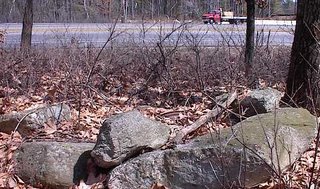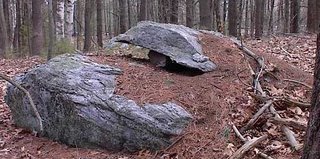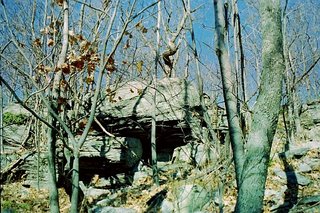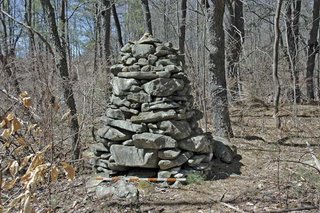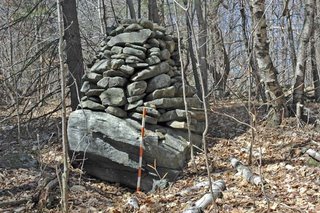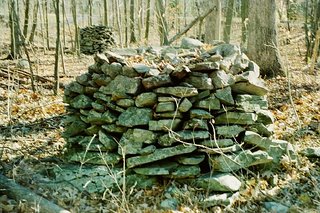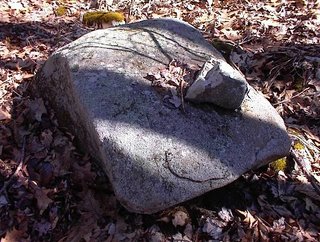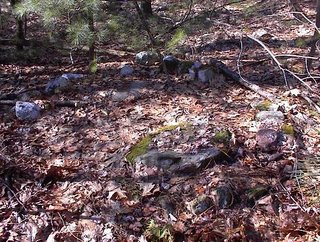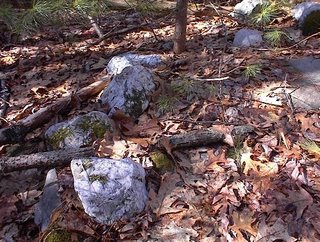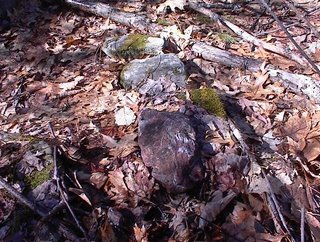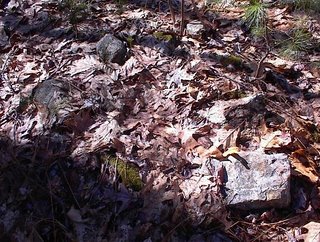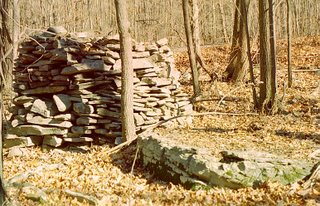I have many more photos of these piles, but I'll just post two more. This one could illustrate the perspective of someone hiding behind one of the piles, watching for quarry if it were a hunting site.

This one, well, it's just pretty.

Here's a picture of the wall I mentioned that goes up the hill at a slant, toward the rock ridge at the top. The theory is that people would have placed sticks with something waving at the tops all along this wall. Members of the party who were hiding behind the rock piles at the bottom would jump out and yell and gesticulate when necessary to chase the game into this corridor, which would be wide at the bottom.
 Then hunters would drive the quarry upward, some probably coming up from the rock piles to line the wall and keep the quarry in. If there were many helping, some could also line the rock ridge above.
Then hunters would drive the quarry upward, some probably coming up from the rock piles to line the wall and keep the quarry in. If there were many helping, some could also line the rock ridge above.
The quarry would then be driven to the bluff where they could either be shot or driven off the edge.

Just speculation, but the terrain and features suggested it. As I said in a comment, we don't know for certain who built this or any of these sites, but the Unami Lenape for example sent hunters to the camps in Poconos in the fall. These people were expected to provide skins, dried meat and other animal products that would make it easier to get through the winter, so they had reason to want to take down large numbers of game, rather than just enough for their own use.
As long as I'm speculating, I'll bring up Mesingwe, the spirit thought to be guardian of the animals. It was he who would be prayed to and possibly propitiated before a hunt. He, it was thought, understood the people's need for game as food and would cause the game to be available or unavailable according to how pleased he might be with them. He is a figure not so different from the European horned god types like Cernunnos, but in form more like a Bigfoot.
Rituals at a hunting site might be centered on him. I pass on this story with trepidation, because it's kind of far out for a down-to-earth forum like this, but with that caveat, here it is. Some say that Mesingwe or Bigfoot likes to eat chipmunks. Chipmunks like to live in walls and stone piles, and can supposedly be scared out by striking the stone piles with a stick. Thus, in a site like this, the piles might serve not only as blinds during hunting but as a form of offering to the animal guardian all year long.
I hasten to say that this was not told to me by Indians but by people talking about Indians, and there may be nothing to it. I pass it along to show that we can't know the traditions of the builders of these sites and therefore we can't know the ritual status or the uses of the sites. What's that quote about archaeology--it's like looking at the props from a play and trying to figure out the plot.
One more interesting note that should probably be mentioned in connection with stone sites from the Poconos north toward the Catskills, traditionally the territory of the Munsee or wolf clan of the Lenape, the word Munsee itself means "at the place where the stones are gathered together." As I've gone up Rte. 209 toward Kingston, NY, I've seen glimpses of interesting walls and piles. More to discover!





